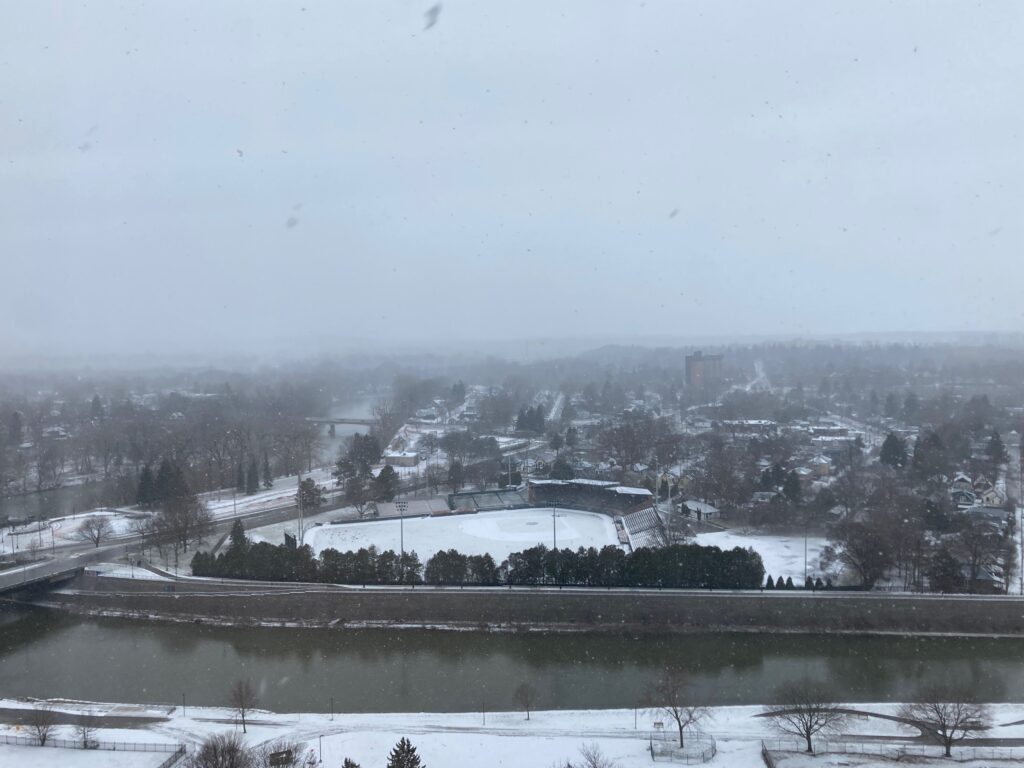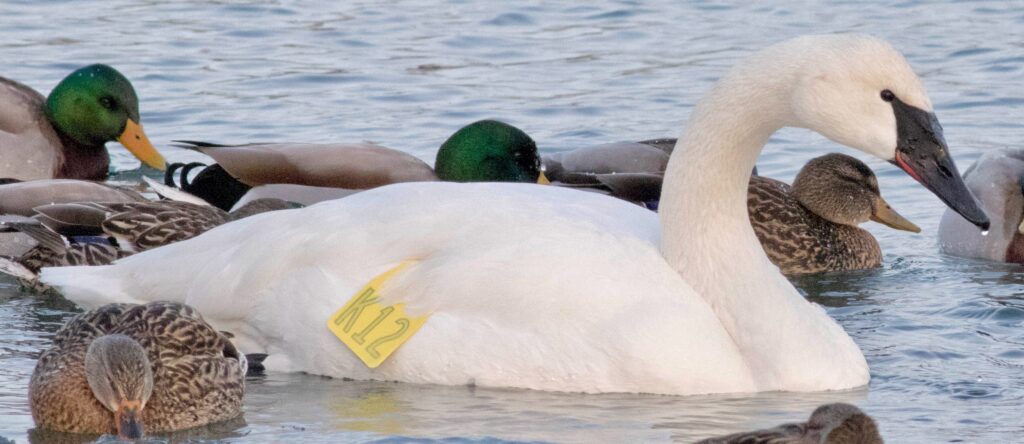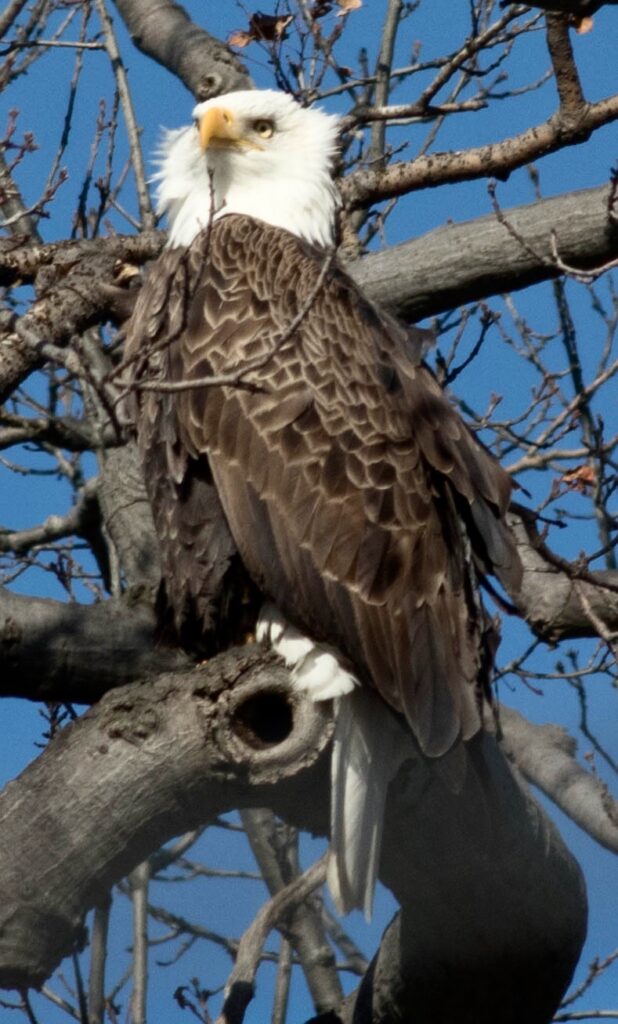Our few warm days with sun have been replaced by cold gloomy weather and a precipitation that is a mix of rain and snow. The saying about March coming in like a lamb, but going out like a lion may hold true this year (as opposed to coming in like a lion and out like a lamb).
On March 26, we awoke to snow.

Perhaps it’s an appropriate time to revisit the rest of the winter birds we encountered in 2018…
Gadwalls are elegant ducks that breed mainly in the central plains of the U.S. and Canada and winter farther south from the central U.S. into Mexico. A few winter in the open water of the southern Great Lakes where they eat mostly submerged vegetation.




Two More Elegant Ducks
American Black Ducks look similar to Mallards and can often be found in their company. Like Mallards, they eat mostly plant matter, adding insects during the breeding season. Black ducks breed throughout northwestern Ontario and Quebec, but some are resident year round in southern Ontario and northeastern U.S.
Ring-necked Ducks are so-named for the subtle reddish ring that is sometimes visible at the base of the male’s neck. Female Ring-necked Ducks are mostly brown with grey faces. They have no neck ring, but do have a grey bill with a white band and black tip similar to the male’s. The question has been asked, why not call these Ring-billed Ducks?! Ring-necked Ducks eat submerged plants and aquatic invertebrates. They breed across most of Canada, but are generally only seen in Southwestern Ontario during migration from their wintering grounds in the southern U.S. and Mexico.


Not an Elegant Duck
According to Britannica, rails are “chicken-shaped marsh birds, with short rounded wings, short tail, large feet, and long toes”. American Coots are a species of rail that breed in freshwater wetlands across much of Canada and the northern U.S. They winter in the southern U.S., Mexico and Central America. They seem to be early migrants who appear in Ontario once there is open water.


According to All About Birds (https://www.allaboutbirds.org/guide/Mute_Swan), all Mute Swans in North America descended from swans imported from Europe from the mid 1800s to adorn large estates, city parks, and zoos. Escapees established breeding populations, including in the Great Lakes, where they disturb local ecosystems and displace native species. When the number of Mute Swans in Lake Ontario increased, conservation authorities took steps to limit reproduction by oiling eggs in nests to prevent hatching.
At the same time, restoration efforts were made to reintroduce native Trumpeter Swans in Ontario. These efforts have been effective in increasing the number of breeding populations in Ontario and beyond. Trumpeter Swan nests are often monitored. Many of the swans are banded with metal leg bands and identified with large yellow plastic wing tags with a three-digit code.
An immature Mute Swan still has a brownish tinge to its feathers and a dusky-pink bill in contrast to the pure white plumage and bright orange bill of the adult.


Trumpeter Swans are larger than Mute Swans. They have black bills that are straighter than the bills of Mute Swans.

Gulls are always a feature along the shores of Lake Ontario. Most commonly seen are Ring-billed Gulls. Herring Gulls are present in smaller numbers. On the right is an adult Herring Gull with an immature Herring Gull below.



In past years, Bald Eagles were occasionally seen along the Toronto shoreline. In 2024, there were reports of the first Bald Eagles nesting in Toronto. The location of the nest was a well-kept secret to protect the birds from enthusiastic onlookers.

Songbirds have a variety of tactics for surviving the winter. Sometimes they take advantage seed scattered along the trails. The Blue Jay below was breaking open a wasp nest to find the soft larvae inside.



Songbirds and squirrels are often seen soaking up the warmth of the winter sun.
Northern Mockingbird, Mourning Dove, Eastern Gray Squirrel (black morph)



Tree Sparrows are winter visitors.


Most Song Sparrows migrate south for the winter, but a few stay if they can find food.


Osprey Update
The female Osprey arrived Thursday afternoon and has been perched on the lights next to the nest and on the low platform that serves as a dining table. We believe this is the female that raised families here for the past four years. Although the male of the Osprey pair is often the first to arrive, “our” female has usually arrived at the nest followed shorthy afterward by the male. This morning, she was on the nest and I made a short video before she left. YouTube
Introducing Ken Marino
Ken Marino has been making television and movie appearances for years, often playing a sympathetic jerk. He is also the lead singer of the Middle Aged Dad Jam Band.
After he calls Kristen Bell “Miss Mars”, she calls Ken “Mr. Van Lowe”, the name of his character on four seasons of Veronica Mars.
On the remaining three songs, the band does a great job of covering three high energy songs.
Susan and I started watching the eight episodes of The Residence on Netflix. Ken is one of the stars. He spends the entire time frantically trying to do damage control after the head usher is found dead in the White House while a state dinner is underway. We loved that the detective in this show is also an avid birder (even though the birding scenes in the series are somewhat lame).
